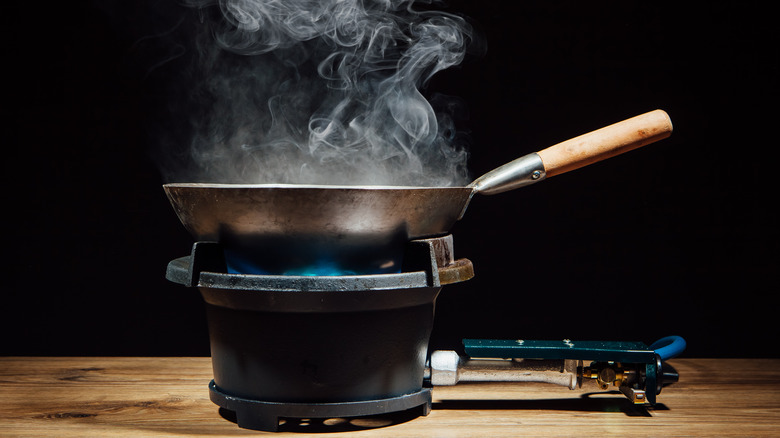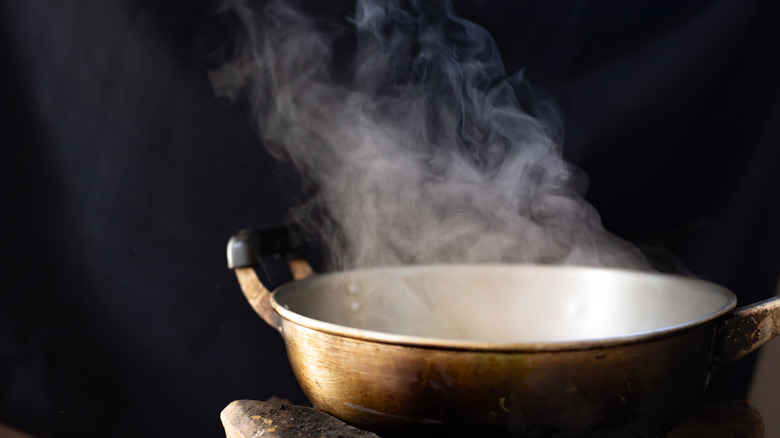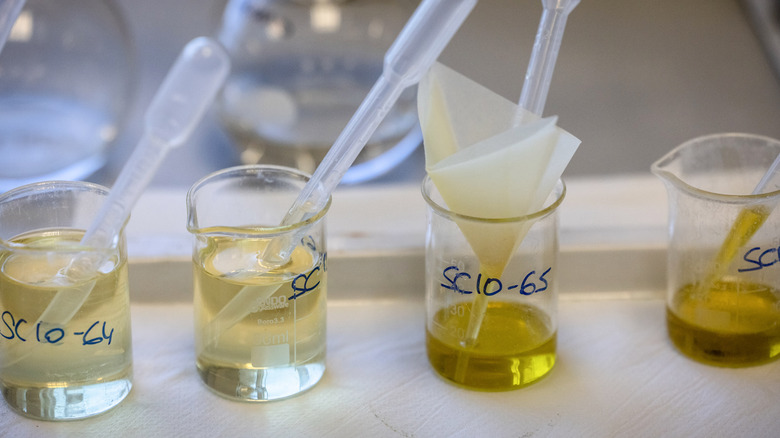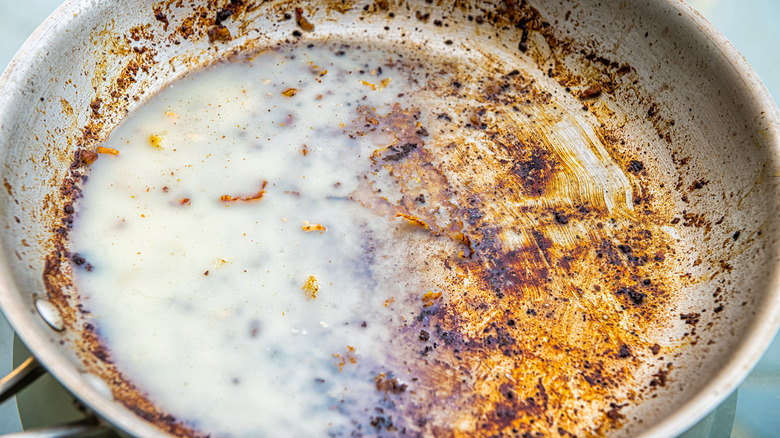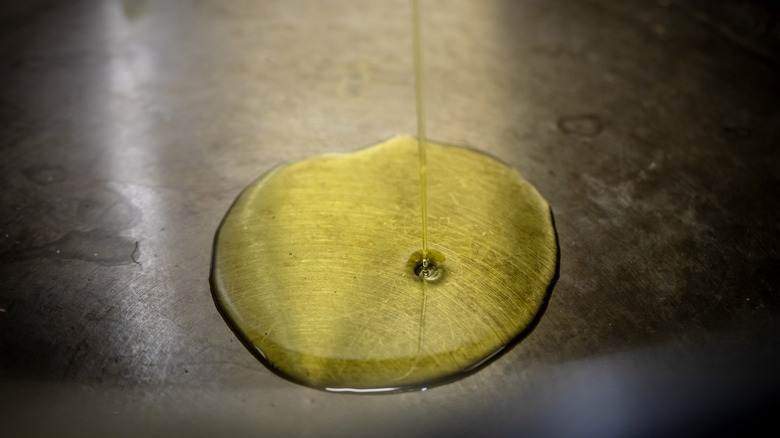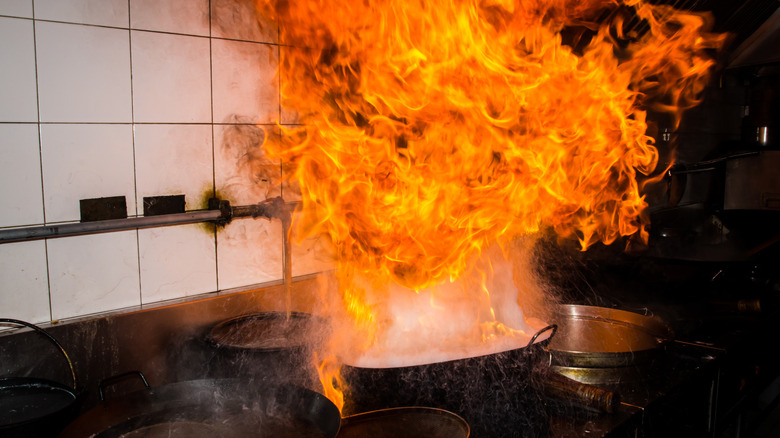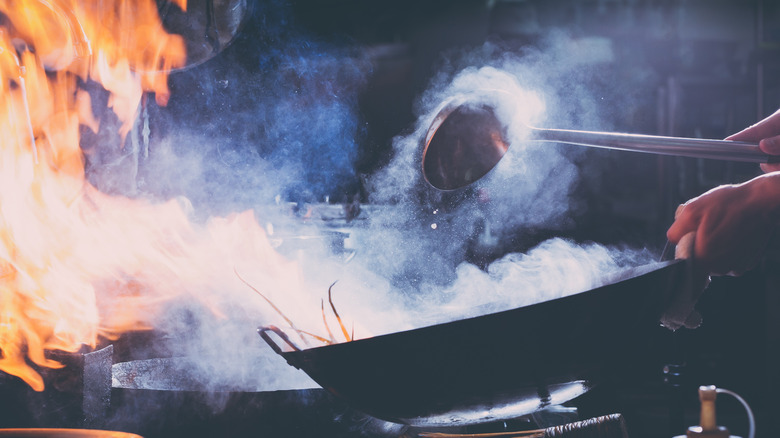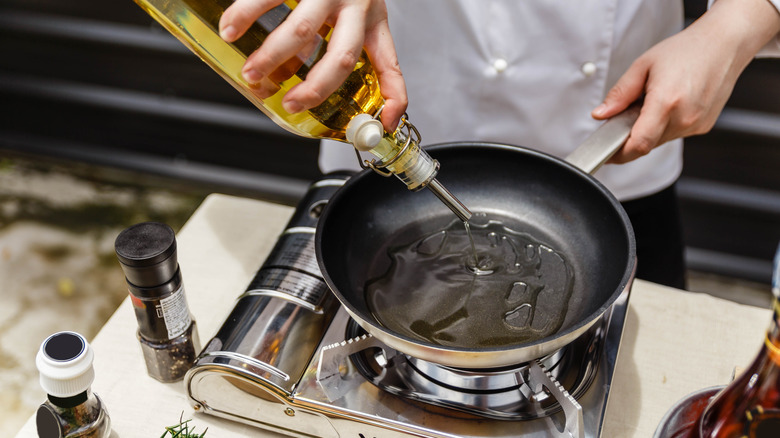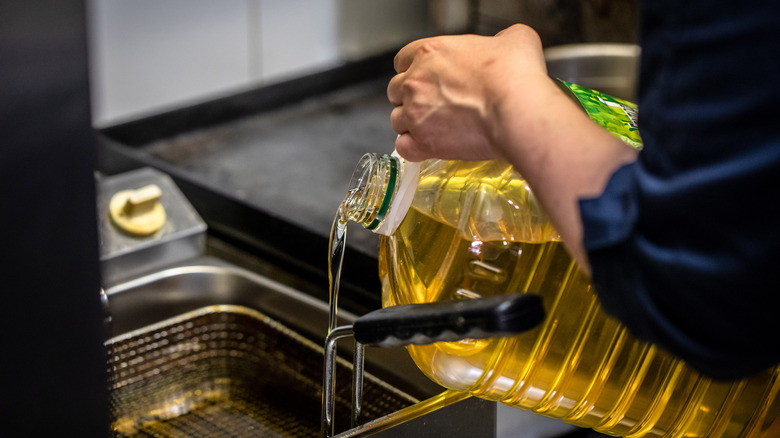The Ultimate Guide To Smoke Points
Discovery reports that fat, in one form or another, has been used as a means of aiding the cooking process since humans started cooking meat thousands of years ago. Since this time, oils attained from animal products, fruits, nuts, seeds, and vegetables have been developed, and now they dominate the market. This is partially thanks to relentless marketing strategies from companies like Procter & Gamble, as highlighted in an extract from the book "The Happiness Diet" published by The Atlantic.
Today, there are numerous types of cooking fats available for home cooks around the world, from avocado oil to lard. While choice is a good thing, too much choice can be overwhelming. This has proven to be the case when it comes to cooking oils, especially given that the internet is full of conflicting information concerning the health impacts of using certain oils, as per Hypereleon.
This information becomes even more complicated when these oils are heated. According to Medical News Today, when oil is heated to its smoke point, it can degrade and become carcinogenic. But what is a smoke point? And how can smoking oil impact both your food and your health? Unfortunately, the answers to these questions are anything but straightforward.
Smoking oil is a tell-tale sign of degradation
To put it simply, an oil reaches its smoke point when smoke begins to consistently rise from it. The process behind this was explained by Leandro Ravetti: "The smoke point of an oil or fat is the temperature at which, under defined conditions, sufficient volatile compounds emerge from the oil and a bluish smoke becomes clearly visible. At this temperature, volatile compounds, such as free-fatty acids, polar compounds and short-chain degradation products, evaporate from the oil." (via U.S. News).
Generally, the smoke point indicates that degradation is occurring, which can result in the production of harmful substances. However, Selina Wang, a research director at the University of California, Davis, highlighted to U.S. News that this isn't always the case. The smoke point is not an indicator of oxidative stability, which is the true measure of an oil's resistance to heat degradation. For example, extra virgin olive oil has a low smoke point but higher oxidative stability than many oils with higher smoke points.
For most people without fancy lab equipment, however, the smoke point is the only means of knowing when cooking oil is degrading. As such it provides a useful, if not truly accurate means of determining when oil becomes destabilized. It is important to note that the smoke point need not be reached for degradation to occur. In fact, degradation occurs naturally over time, even when oil is stored at room temperature (via The New York Times).
Chemical bonding affects an oil's smoke point
An oil's smoke point depends on several factors, a primary one being the type of fat that is present within it, as per Verywell Fit. The same publication reports that oils that are rich in polyunsaturated fat, like walnut oil, generally have a low smoke point. These fats are usually healthier than their saturated counterparts — however, they are more vulnerable to damage from heat. According to Steve Grant Health, this is because of the high number of double bonds present within the fatty acid chains, which makes their chemical composition less stable.
By comparison, the same source reports that monounsaturated fats only feature one double bond. This means that oils with a high amount of monounsaturated fats, like olive oil, tend to be more resistant to heat damage, and have higher smoke points. These oils and fats also provide some of the health benefits associated with polyunsaturated fats (via the American Heart Association).
Finally, saturated fats only have single bonds present in their fatty acid chains, per Healthline. This means oils with a high percentage of saturated fats, like coconut oil, usually have high smoke points and are not easily degraded by heat. However, ingestion of saturated fats can elevate blood cholesterol levels, leading to a number of potentially fatal illnesses such as heart disease, according to the American Heart Association.
An oil's smoke point can vary greatly depending on how it is processed
Importantly, it is not just bonding that influences an oil's smoke point and resilience to heat but a number of other factors as well. One of these is how refined the oil is. Refining refers to a number of processes including bleaching and filtering that remove organic compounds from the oil, thus raising the smoke point (via What's Cooking America). However, stripping out these organic substances also removes a lot of the nutrients and enzymes which make unrefined oils, like extra-virgin olive oil, so healthy, as per Branch Basics.
As previously mentioned, oils are degrading all the time, just at a slow rate, meaning that an oil's age also contributes to how degraded it is. Changes in air, light, and heat all cause oxidation to occur which, over time, can significantly lower an oil's smoke point, as per Frymax.
Finally, The New York Times reported that some oil sold as extra virgin olive oil is nothing of the sort. Rather it is lower-grade olive oil cut with a number of other oils and substances. Evidently, this will affect its smoke point along with many of the oil's other characteristics. As a consequence of all these variables, it is clear that smoke points can greatly vary not just between oils sourced from different foods, but also from brand to brand and even batch to batch.
Going above the smoke point can affect the taste of your food
Cooking with oil that is at or beyond its smoke point is not advisable. Aside from the formation of potentially harmful compounds, the oil will begin to impart an acrid taste and rancid smell to your food (via The Washington Post). One of the sources of this unpleasant flavor is a substance called acrolein.
As described in Molecular Nutrition and Food Research, acrolein is a chemical compound that can be formed during the heating and burning of animal and plant fats. Acrolein has been known to impart a bitter, unpleasant taste to wine (via Food Chemistry Advances). It's also naturally present in many foods, from fruits to vegetables to cod filets (per Foods).
As reported by IFT, acrolein forms rapidly at an oil's smoke point because of these high temperatures cause the triglycerides to break down into fatty acids and glycerol. The glycerol is then dehydrated to form acrolein. This means that the best way to inhibit acrolein production is to avoid the breakdown of triglycerides by cooking well below an oil's smoke point. Furthermore, some oils, such as extra virgin olive oil, produce much lower levels of acrolein than others suggesting that this type of oil should be used by those who are eager to minimize the amount of acrolein in their food (via Food Science and Technology Research).
Acrolein is a health risk
Aside from making your food taste and smell bad, acrolein is also a potentially hazardous compound both when inhaled or ingested, per Delaware Health and Social Services. The low levels of gaseous acrolein most of us are exposed to through frying, the combustion of fossil fuels, and tobacco burning causes only minor issues such as irritation of the respiratory system. On the other hand, chronic exposure, which might be experienced by cooks working with consistently overheated deep fryers, can result in damage to the lining of the lungs, according to the U.S. Department of Health and Human Services.
Acrolein has a strange property when ingested: people who eat foods with small amounts of acrolein can end up with much higher levels of it in their bodies than what was present in the food. This is because previously eliminated acrolein can re-form inside the human body as food is broken down (via Foods). This means that trying to estimate internal acrolein levels from the acrolein content of foods is an inaccurate practice. That being said, it is commonly known that consuming foods is one of the main ways humans come into contact with this hazardous compound. Ingestion of concentrated acrolein (more than what you would find in food) has been reported to cause burning of the mouth and vomiting, per Delaware Health and Social Services. What's more, chronic acrolein consumption has been linked to various cancers throughout the digestive tract (via Scientific Reports).
Heating oil past the smoke point can create potentially harmful free radicals
Aside from acrolein, the heating and degradation of fats and oils can also lead to the production of free radicals, according to The Seattle Times. The same publication goes on to report that free radicals are molecules with a single electron, making them highly unstable. Because of this, free radicals can interact with body tissues to cause numerous negative impacts on human health including cancer and cardiovascular disease, per Pharmacognosy Review. As such, it is advisable to limit free radical production by cooking below oil smoke points.
The Seattle Times also highlights that one of the best ways to regulate free radicals is to consume antioxidants. These compounds can be found in a variety of foods — including spices, herbs, fruits, and vegetables (via Nutrition Journal) — and are known to inhibit the process of oxidation, as reported by National Center for Complementary and Integrative Health. Using antioxidant-rich fats and oils, such as extra virgin olive oil, can further supplement your diet with these beneficial compounds, helping to protect you against harmful free radicals (via BBC).
There are several further risks of cooking past the smoke point
As we have seen, heating your oil above its smoke point can ruin it. The taste and smell are compromised, while dangerous compounds such as acrolein and potentially hazardous free radicals form. These hazardous compounds can provide immediate danger, with even low levels of acrolein inhalation capable of causing respiratory irritation, particularly in children (via the Agency for Toxic Substances and Disease Registry). Heating cooking oil well past its smoke point can also pose further serious and immediate dangers due to something called the flash point.
Depending on the oil, the flash point can occur from around 520 degrees Fahrenheit and above, as per Bailey's Industrial Oil and Fat Products. The flash point is when the products in the oil ignite, causing flames to rise from the oil. This can turn your pot of oil into a raging grease fire. Of course, any uncontrolled flames pose a huge risk to humans and should be dealt with immediately by turning off the heat source. If possible, the pan should also be covered with a metal lid to starve the flames of oxygen, according to Reader's Digest.
Just above the flash point comes the fire point, which occurs at approximately 700 degrees Fahrenheit (via Kumar Metal Industries). This is the point that the fire becomes self-sustaining. At this point, there is a very real possibility you will need to call in the fire department.
Exceeding the smoke point is sometimes unavoidable
According to Weber the ideal temperature range to sear meat is between 300 and 500 degrees Fahrenheit. Unfortunately, this is also the range in which the vast majority of cooking oils reach their smoke points. However, there are a few widely available cooking oils that have smoke points that exceed 500 degrees Fahrenheit, including avocado oil (per NBC News) and safflower oil (via MasterClass). Add to this the fact that searing may take place on a grill — with associated difficulties in accurate temperature control — and it's easy to see how the searing process can often occur above an oil's smoke point. Ideally, this should be avoided through the use of accurate temperature control and refined, high-smoke point oils. If that is not possible, try to use a small amount of oil — or if possible, none at all — in order to minimize the formation of bitter, hazardous compounds such as acrolein. You may also choose to sear with extra virgin olive oil, which despite its moderate smoke point is resistant to degradation at high temperatures, per U.S. News.
Another example of when smoke points might be exceeded is stir-frying; ripping hot woks can usually reach temperatures exceeding 450 degrees Fahrenheit, a fact attested to by research performed by the team at Serious Eats. Again, try to limit the frequency in which you cook in this manner or purchase a high-smoke point oil specifically for this use.
Oils with low smoke points should be used for dressings
The emphasis on avoiding heating oil to its smoke point can, quite understandably, lead people to only purchase oils with high smoke points. This approach may not be the best, however, as low-smoke point oils are usually packed with both nutrients and flavor. For example, unrefined walnut oil — which has a relatively low smoke point of 320 degrees Fahrenheit (via WebMD) — is rich in antioxidants such as selenium and omega 3 fatty acids which improve heart health.
Due to their low smoke points, oils such as walnut are best used in culinary applications which do not involve a great degree of heat, namely as finishing oils or salad dressing ingredients, per What's Cooking America. In these scenarios, the flavorful nature of the oil can add an interesting dimension to the dish while also providing the oil's associated health benefits.
Mid-smoke point oils have various uses
By their nature, oils that have a mid-range smoke point — around 400 degrees Fahrenheit — are extremely versatile, being suitable for use in various cooking processes and for finishing dishes. A popular group of mid-smoke point oils are vegetable oils, as is attested to by forecasts that predict the U.S. market for vegetable oils alone will be worth more than $345 billion by 2029, per Data Bridge Market Research (via PR Newswire). Among this subgroup, canola oil is often used because it is low in saturated fats and rich in vitamins E and K, as reported by Healthline.
Thanks to its middle-of-the-road smoke point, canola oil is suitable for sautéing and baking as the temperatures used during these processes are generally low enough to avoid degradation. Canola oil's low levels of saturated fats mean it can also be used as a relatively healthful salad dressing ingredient, although its neutral taste (via Healthline) will mean it adds less flavor than other oils such as walnut oil. Also, since canola oil is a highly refined and processed product, it may be less beneficial to your health than some other types of oil.
Oils with a high smoke point are best for deep frying
There are several oils with extremely high smoke points including the aforementioned safflower oil. However, one of the most widely used high smoke point oils is derived from peanuts. Peanut oil is widely used in the hospitality industry as it is uniquely suited for making deep fried foods. This is due to both its high smoke point and the fact that it does not absorb the flavor of the food that is immersed in it (via The Peanut Institute). This means that the oil can be reused several times or used to cook different items at the same time without fear of altering flavors.
As with several heat-resistant oils — like coconut oil and palm oil (via Verywell Fit) — peanut oil has a high percentage of saturated fat, meaning it is less healthy than oils that predominantly contain monounsaturated or polyunsaturated fats, as per Livestrong. This suggests that peanut oil should be used infrequently, and only for cooking processes that require a higher smoke point. Using saturated fats for low or no-heat cooking methods, such as sautéing or being used as salad dressing, will result in an unnecessarily high amount of saturated fat being consumed, a dietary practice that could ultimately lead to poor health (per National Health Service).
